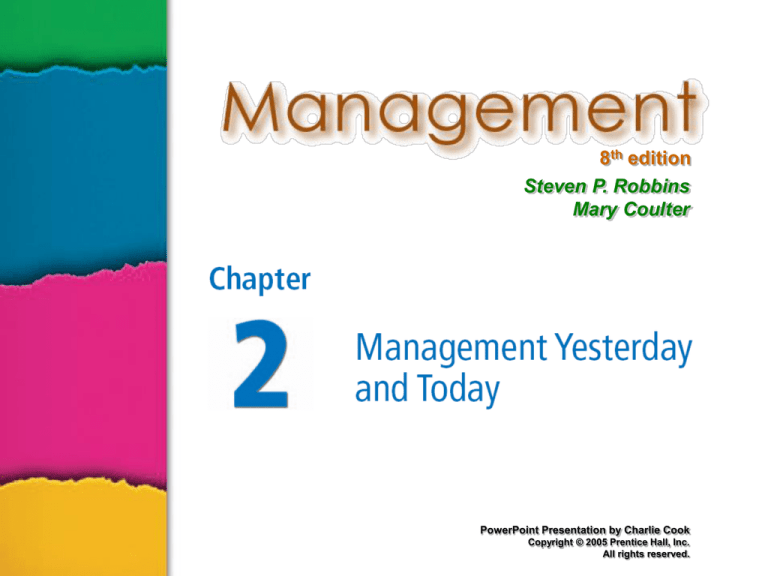
8th edition
Steven P. Robbins
Mary Coulter
PowerPoint Presentation by Charlie Cook
Copyright © 2005 Prentice Hall, Inc.
All rights reserved.
Historical Background of Management
• Ancient Management
• Organized jobs directed by people responsible for planning,
organizing, leading, and controlling activities have existed for
thousands of years.
Egypt (Pyramids) and China (The Great Wall)
Venetians (floating warship assembly lines)
• Adam Smith
Published “The Wealth of Nations” in 1776
Advocated the division of labor (job specialization) to increase
the productivity of workers.
• Industrial Revolution
Substituted machine power for human labor
Created large organizations in need of management
2–2
ftp://172.17.1.4/admin-team/Management/Michael
Major Approaches to Management
• Scientific Management
• General Administrative Theory
• Quantitative Management
• Organizational Behavior
• Systems Approach
• Contingency Approach
2–3
ftp://172.17.1.4/admin-team/Management/Michael
Development of Major Management Theories
Exhibit 2.1
2–4
ftp://172.17.1.4/admin-team/Management/Michael
Scientific Management
• Frederick Winslow Taylor − The “father” of scientific
management.
Published Principles of Scientific Management (1911)
The
use of scientific methods to define the “one best way”
for a job to be done.
• Putting the right person on the job with the correct tools
and equipment.
• Having the worker follow instructions exactly or use a
standardized method of doing the job.
• Motivating the worker with an economic incentive (bonus) of
a higher wage.
2–5
ftp://172.17.1.4/admin-team/Management/Michael
Scientific Management (cont’d)
• Frank and Lillian Gilbreth
Focused on increasing worker productivity through the
reduction of wasted hand and body motions.
Experimented with tools and equipment to optimize (get the
most out of) work performance.
Developed the microchronometer to time worker motions
and optimize performance.
• Today’s use of scientific management:
Analyze the work tasks to be performed
Use time-and-motion study to eliminate wasted motions
Hire the best qualified workers for a job
Design incentive (bonus, reward) systems based on output
(production).
2–6
ftp://172.17.1.4/admin-team/Management/Michael
General Administrative Theorists
• Henri Fayol
Described management as a set of functions that included
planning, organizing, commanding, coordinating, and
controlling.
Believed that the practice of management was distinct from
other organizational functions.
Developed fourteen principles of management that applied
to all organizational situations.
• Max Weber
Developed a theory of authority based on an ideal type of
organization: bureaucracy
Emphasizing
rationality, predictability, impersonality, technical
competence, and authoritarianism
2–7
ftp://172.17.1.4/admin-team/Management/Michael
General Administrative Theorists (Vocabulary)
Rationality: Having good sense, sound judgment
Predictability: capable of being known in advance
Impersonality: Without preference to individual persons
Competence: Good physical and intellectual ability
Authoritarianism: Centrally managed by a single
individual or small group
2–8
ftp://172.17.1.4/admin-team/Management/Michael
Fayol’s 14 Principles of Management
1. Division of work.
7.
Remuneration.
2. Authority.
8.
Centralization.
3. Discipline.
9.
Scalar chain.
4. Unity of command.
10. Order.
5. Unity of direction.
11. Equity.
6. Subordination of
individual interest
to the interests of
the organization.
12. Stability of tenure
of personnel.
13. Initiative.
14. Esprit de corps.
Exhibit 2.3
2–9
ftp://172.17.1.4/admin-team/Management/Michael
Weber’s Ideal Bureaucracy
Exhibit 2.4
2–10
ftp://172.17.1.4/admin-team/Management/Michael
General Administrative Theories
Today’s use of general administrative
theories of management:
•
Many contemporary (today’s) managers feel that
“bureaucracy” takes away employees’ creativity
and the organization’s ability to respond quickly
to a dynamic (changing) environment. Yet today
some bureaucratic mechanisms (processes) are
necessary to ensure that resources are used
efficiently and effectively.
2–11
ftp://172.17.1.4/admin-team/Management/Michael
Quantitative Approach to Management
• The Quantitative Approach
Also called operations research or management science
Evolved from mathematical and statistical methods
developed to solve WWII military logistics and quality
control problems
Focuses on improving managerial decisions by applying:
Statistics
(data), optimization models (improvement theories),
information models (use of recorded information), and
computer simulations (the technique of using a computer
program to create a virtual representation of what can possibly
happen).
2–12
ftp://172.17.1.4/admin-team/Management/Michael
Quantitative Approach to Management
Today’s use of the quantitative approach to
management:
The availability of software programs has made
the use of quantitative techniques easier for
managers. Today, when managers make
budgeting, scheduling, quality control, and
similar decisions, they rely on quantitative
techniques.
2–13
ftp://172.17.1.4/admin-team/Management/Michael
Understanding Organizational Behavior
• Organizational Behavior (OB)
The study of the actions of people at work.
The early advocates of OB believed that people were the most
important asset of an organization
Their ideas provided the basis for employee selection procedures,
motivation programs, work teams and working environment
management techniques.
Behavior: Way of relating to other humans, conduct.
Research conclusion of the Hawthorne Studies
Social norms, group standards and attitudes more strongly influence
individual output and work behavior than do monetary incentives.
2–14
ftp://172.17.1.4/admin-team/Management/Michael
Today’s Use of Organizational Behavior
The behavioral approach is widely used in
today’s organizations as can be seen in:
• --The way managers design motivating jobs
• --The way they work with employee teams
• --The way they use open communication.
Early OB and the Hawthorne studies provided the basis for
our current (today’s) theories of motivation, leadership,
group development and other behavioral topics.
2–15
ftp://172.17.1.4/admin-team/Management/Michael
The Systems Approach
• System Defined
A set of interrelated (all connected) and interdependent (depend on
each other) parts of an organization that work together as a whole to
achieve goals.
• Basic Types of Systems
Closed systems
Are not influenced by and do not interact with their
environment. Inputs and outputs are internal.
Open systems
Dynamically interact with their environment. They collect
inputs (resources) from the environment and transform them
into outputs that are distributed into the environment.
2–16
ftp://172.17.1.4/admin-team/Management/Michael
The Organization as an Open System
Exhibit 2.6
2–17
ftp://172.17.1.4/admin-team/Management/Michael
Implications (meanings/ideas) of the Systems
Approach
How the systems approach is appropriate for
understanding management:
• Coordination of the organization’s parts is essential
for proper functioning of the entire organization.
• Decisions and actions taken in one area of the
organization will have an effect in other areas of the
organization.
• Organizations are not self-contained and, therefore,
must adapt to changes in their external environment.
Self-contained: Complete and independent in and of itself. E.g. The
university is like a self-contained city with shops and conveniences.
2–18
ftp://172.17.1.4/admin-team/Management/Michael
The Contingency Approach
• Sometimes called the situational approach.
• The contingency approach differs from the early theories of
management insofar as:
Organizations are different from one another, there is no
single universally applicable set of management
principles (rules) by which to manage all organizations.
Organizations face different situations (or contingencies =
changing events/conditions), and require different ways of
managing depending on the present conditions.
2–19
ftp://172.17.1.4/admin-team/Management/Michael
Current Trends and Issues
• We need to look at these current trends and issues
because they are changing the way managers do
their jobs.
• -- Globalization
• -- Ethics
• -- Workforce Diversity
• -- Entrepreneurship
• -- E-business
• -- Knowledge Management
• -- Learning Organizations
• -- Quality Management
2–20
ftp://172.17.1.4/admin-team/Management/Michael
Current Trends and Issues (cont’d)
• Globalization
Management in international organizations
Political and cultural challenges of operating in a
global market
• Ethics
Increased emphasis on ethics education (the study of
moral values and rules) in college curriculums
Increased creation and use of codes of ethics by
businesses (sets of rules and principles directing the conduct
of employees in deciding what is right and wrong when faced
with difficult choices)
2–21
ftp://172.17.1.4/admin-team/Management/Michael
Current Trends and Issues (cont’d)
• Workforce Diversity
Increasing heterogeneity in the workforce
In
terms of gender, race, ethnicity and other forms of
diversity in the workforce.
Aging workforce
Older
employees who work longer and do not retire
The
increased costs of public and private benefits for
older workers
An
increasing demand for products and services related
to aging.
2–22
ftp://172.17.1.4/admin-team/Management/Michael
Current Trends and Issues (cont’d)
• Entrepreneurship
The process whereby an individual or group of
individuals uses organized efforts to create value and
grow by fulfilling wants and needs through innovation
and uniqueness.
• Entrepreneurship themes (forms & ideas)
The pursuit (search) of opportunities
Innovation in products, services, or business methods
A desire for continual growth of the organization
2–23
ftp://172.17.1.4/admin-team/Management/Michael
Current Trends and Issues (cont’d)
• E-Business (Electronic Business)
An organization that does its work performed by using
electronic linkages – the Internet – to its key constituencies
(members, parts, components of the organization).
E-commerce
The sales and marketing component of an e-business that
uses electronic linkages to the public.
2–24
ftp://172.17.1.4/admin-team/Management/Michael
Current Trends and Issues (cont’d)
• Knowledge Management
The cultivation (development) of a learning culture
(mental attitude) where organizational members
systematically gather and share knowledge with
others in order to achieve better performance.
• Learning Organization
An organization that has developed the capacity to
continuously learn, adapt, and change.
2–25
ftp://172.17.1.4/admin-team/Management/Michael
Learning Organization versus Traditional
Organization
Exhibit 2.10
2–26
ftp://172.17.1.4/admin-team/Management/Michael
Current Trends and Issues (cont’d)
• Quality Management
A philosophy of management that is committed to
(aimed at) continuous improvement in the quality of
work processes and responding to customer needs
and expectations.
Inspired by the total quality management (TQM) ideas
of Deming and Juran
Quality is not directly related to cost; low quality may
result in higher costs to the organization.
2–27
ftp://172.17.1.4/admin-team/Management/Michael
What is Quality Management?
•Intense focus on the customer.
•Concern for continual improvement.
•Process-focused, e.g. quality of goods.
•Improvement in the quality of everything
the organization does.
•Accurate measurement: Comparing the
state of operations against standards.
•Empowerment of employees: Involving
people in the improvement process.
Exhibit 2.11
2–28
ftp://172.17.1.4/admin-team/Management/Michael
Chapter review
o Historical Background of Management pg. 25
• Explain why studying management history is important.
• Describe some early evidences of management practice.
• Scientific Management pg. 27
• Describe the important contributions made by Fredrick W.
Taylor and Frank and Lillian Gilbreth.
• Explain how today’s managers use scientific management.
2–29
ftp://172.17.1.4/admin-team/Management/Michael
Chapter review (cont’d)
oGeneral Administrative Theorists pg. 28
• Discuss Fayol’s 14 management principles.
• Describe Max Weber’s contribution to the general
administrative theory of management.
• Explain how today’s managers use general administrative
theory.
oQuantitative Approach to Management pg. 30
• Explain what the quantitative approach has contributed to
the field of management.
• Discuss how today’s managers use the quantitative
approach.
2–30
ftp://172.17.1.4/admin-team/Management/Michael
Chapter review (cont’d)
•Toward Understanding Organizational Behavior pg.
31
• Explain the conclusions of the Hawthorne Studies.
• Discuss how today’s managers use the behavioral
approach.
oThe Systems Approach pg. 33
• Describe an organization using the systems approach.
• Discuss how the systems approach is appropriate for
understanding management.
2–31
ftp://172.17.1.4/admin-team/Management/Michael
Chapter review (cont’d)
oThe Contingency Approach pg. 35
• Explain how the contingency approach differs from the
early theories of management.
• Discuss how the contingency approach is appropriate for
studying management.
oCurrent Issues and Trends pg. 36
• Explain why we need to look at the current trends and
issues facing managers.
• Describe the current trends and issues facing managers.
2–32
ftp://172.17.1.4/admin-team/Management/Michael


